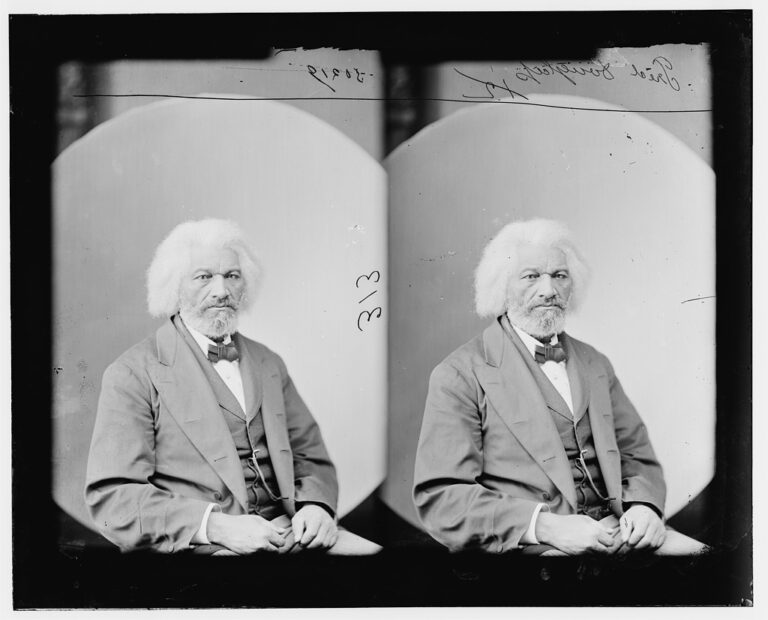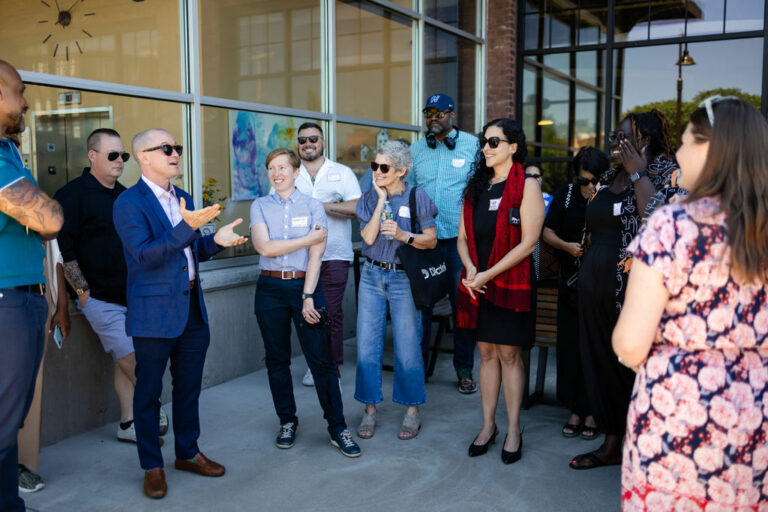
Schomburg Center for Research in Black Culture, The New York Public Library.
“A Great and Difficult Progressive”
Editor’s Note: David Levering Lewis delivered this address to the Great and General Court of the Commonwealth of Massachusetts on February 28, 2018, in commemoration of the 150th anniversary of the birth in Great Barrington of W.E.B. Du Bois. Professor Lewis kindly gave Mass Humanities permission to publish his remarks.
In this month of emancipators–Washington, Lincoln and Frederick Douglass–we gather together in the people’s house to honor native son William Edward Burghardt Du Bois, born February 23rd, a Sunday, 150 years ago on Church Street in Great Barrington, Massachusetts.
The birth certificate reads William E. Du Boise, “colored,” issue of Alfred Duboise and Mary (her Burghardt maiden name unmentioned), whose February 5th nuptials in the nearby village of Housatonic the previous year had been duly noted in the Berkshire Courier. Alfred Du Bois, a Union Army veteran who gave his birthplace as San Domingo, Haiti, departed in murky circumstances soon thereafter, leaving wife and newborn in the tenuous care of Alfred’s Burghardt in-laws.
Du Bois left Great Barrington at age seventeen, returning during the following four score years only infrequently, and usually for brief stays: memorably, in late May of 1899, when he and new wife Nina came to bury their baby son, Burghardt; then again in early July, fifty years later, to bury wife Nina; and again for the last time with the remains of daughter Yolande before self-exile in Ghana in October 1961.
“The color line was manifest” in Great Barrington, Du Bois wrote, “and yet not absolutely drawn.” “I very early got the idea,” he would tell the interviewer from Columbia University’s oral history project “that what I was going to do was to prove to the world that Negroes were just like other people.” Yet he sensed early that he was something of a curiosity to the white townspeople.
“The color line was manifest” in Great Barrington, Du Bois has written, “and yet not absolutely drawn.”
With that flare for drama in language in which he has few equals, Du Bois pinpoints, in The Souls of Black Folk, the exact moment in his ten-year-old life, a spring day in 1878, when, as he says, “I remember well when the shadow swept across me. . . In a wee wooden schoolhouse, something put it into the boys’ and girls’ heads to buy gorgeous visiting-cards—ten cents a package—and exchange. The exchange was merry, till one girl, a tall newcomer, refused my card—refused it peremptorily. Then it dawned upon me with a certain suddenness that I was different from the others; or like, mayhap, in heart and life, and longing, but shut out from their world by a vast veil.”
In the case of the sweeping shadow and separating veil, Du Bois has given several versions. But what is clear is that he extracted both his seminal concept of the divided self and his powerful metaphor of the veil from his pubescent Great Barrington years.
In 1880s America, not even the sons of mill owners (and but the rarest daughter) took college education as a matter of course. Du Bois recalled that maybe two others in his high school graduating class of thirteen were heading for college. Even his supercharged ambition at first failed to grasp the value a college education might have for a colored man. That was high school Principal Frank Hosmer’s doing. Hosmer did more, for the unravelling Burghardt clan’s limited resources could hardly afford the college-course textbooks on Greek, Latin, algebra, and geometry. Classmate Louis Russell’s mother, second wife of Farley Russell the mill owner, agreed to buy them, after Hosmer spoke with her.
There were seven boys and six girls in Willie’s June 1884 graduation class. His mother and other Burghardts heard him deliver an oration on Wendell Phillips, the conscience of New England abolitionism. It was the success of the evening, the Berkshire Courier reporter judging that “William E. Dubois [sic] a colored lad who has had good standing” gave an excellent oration and “provoked repeated applause.” But he was not going to Harvard. Not even to Williams College. Money remained a big problem, of course. Principal Hosmer arranged for four Congregational churches to pledge twenty-five dollars each for four years to underwrite Du Bois’s education at Fisk University, a Congregational school for Negroes in Nashville, Tennessee. Harvard was not lost—the thought never occurred to him—merely adjourned.

Du Bois was off to Fisk University. For him, it was a great adventure into the unknown. His memory of his first dining hall supper he carried to his grave. At age 92, Du Bois would animatedly tell the Columbia University Oral History Project interviewer of meeting Lena Horne’s aunt. “She was beautifully dressed–oh, a perfectly lovely girl.” No Fisk woman would ever refuse his card because he was black. Graduating with highest honors after three brilliant years at Fisk, Great Barrington’s brown ambassador entered Harvard College in September 1888.
Harvard and Yale traditionally required African American baccalaureates to repeat a portion of their undergraduate training before pursuing graduate degrees, a requirement frequently imposed on white graduates of undistinguished colleges. Helped by a bequest from his mysterious father’s father and a college scholarship, Du Bois entered Harvard College as a junior, the sixth of his race to do so. He graduated magna cum laude with a concentration in philosophy under William James in the class of 1890.
Remarkably, a special scholarship permitted matriculation at Germany’s premier university—Friedrich Wilhelm Universitaet—where Du Bois came within months of earning a coveted doctorate in economics. He would, however, be the first of his race to win a Harvard doctorate in 1896. Later, he haughtily allowed later that it was a consolation for having been denied the few additional months needed to return to the States with a prized German degree. His 1896 history dissertation on the suppression of the Atlantic slave trade to the United States was an immediate classic, the first history monograph published in Harvard’s new historical series. The Philadelphia Negro (1899) was recognized as a methodological breakthrough in the social-sciences.
But a score of years after departing his birthplace, William Edward Burghardt Du Bois’s renown as a scholar and what today we call a public intellectual achieved an unparalleled eminence with the publication in 1903 of a collection of fourteen bombshell essays that could only be described as sui generis.
The Souls of Black Folk explained Americans of color to themselves with a saliency that still inspires and defines today. The 35 year–old author was the first to grasp the international implications of the struggle for racial justice, memorably proclaiming, at the dawn of the century, that the problem of the twentieth century would be the problem of the color line. He was a principal founder of the NAACP, the nation’s oldest civil rights association, created one hundred nine years ago this month, and whose militant monthly, The Crisis, he edited as the voice of uncompromising racial equality for a quarter century. No exaggeration to state that a majority of literate African American households were weaned on Du Bois’s monthly—even those beholden to the adversary legacy of Booker T. Washington.
“It was never possible to know where the scholar Du Bois ended and the organizer Du Bois began. The two qualities in him were a single, unified force.”
Dr. Martin Luther King, Jr.
A Du Bois bibliography runs to sixteen pioneering books of sociology, history, politics, and race relations. In his seventies, he found time to finish a second autobiography (the splendid Dusk of Dawn) and to produce three large historical novels, complementing the two large works of fiction written in the first two decades of the twentieth century that anticipated the so-called Harlem Renaissance. All Americans owe Du Bois a considerable debt for the historical masterpiece Black Reconstruction in America (1935), which changed forever our understanding of the shameful suppression of racial democracy in the post-Civil War South. The long march from the Supreme Court’s Plessy v. Ferguson’s “separate but equal” equivocation in 1896 to Brown v. Board’s mandate for integration in 1954 would have been even longer and harder without his mind and pen. Du Bois cut an amazing swath through four continents (he institutionalized the Pan African Movement, was a Lenin Peace Prize laureate, and his birthday was once a national holiday in China).
A new edition of The Souls of Black Folk is forthcoming this month. Properly so, because this book is both timeless while being also time-bound. Like the public’s immutable memory of Martin Luther King’s Dream Speech, so its vivid retention of Du Bois’s color-line prophesy has meant that the evolved ideas both Du Bois and King held in their last years are forgotten, unknown, deemed subversive—or all of the above. We should probably not expect to see the release of a new edition of In Battle for Peace, Du Bois’s account of his 1952 Justice Department indictment, trial, and embarrassed acquittal in Washington as a foreign agent. In one of his last jeremiads before exiling himself to Ghana, he called for the restoration of democracy in America. “Make it again possible for the people to express their will,” he implored. “Today the rich and the powerful rulers of America divide themselves into Republicans and Democrats in order to raise [millions of] dollars to buy the next election and prevent you from having a third party to vote for, or to stop war, theft and murder by your votes.”
Massachusetts-born and bred Du Bois criticized his country’s shortcomings as much from a youthful Calvinist’s intolerance of moral slothfulness as from an aged Marxist’s impatience with the rigged outcomes of unregulated capitalism. Famous at fifty, Du Bois often claimed that his death was practically requested at seventy-five. He dismissed Brown v. Board’s “all deliberate speed” time table as fraudulent and he characteristically looked upon the ultimate value of citizenship for people of color in America with the gravest misgivings if that citizenship were to mean that the peoples of Africa and Asia were to become subjects under a Pax Americana maintained for the profit of the military-industrial-financial-complex.

Martin Luther King, Jr., famously told a capacity Carnegie Hall audience on the centenary of Du Bois’s birth that “It was never possible to know where the scholar Du Bois ended and the organizer Du Bois began. The two qualities in him were,” he said, “a single, unified force.”
“History cannot ignore Dr. Du Bois,” King insisted. Yet, when he spoke these words five years after Du Bois died in Accra, Ghana, Du Bois had been virtually excised from his country’s mainstream narrative as an expatriate and a communist. “Our irrational, obsessive anti-communism has led us into too many quagmires to be retained as if it were a mode of scientific thinking,” Dr. King went on the say, and he reminded his audience that Abraham Lincoln had “warmly welcomed the support of Karl Marx during the Civil War and corresponded with him freely.” The old contrarian’s death had come as Dr. King prepared to deliver his Dream Speech from the Lincoln Memorial steps in 1963. The generational baton had passed that day with stunning symbolic appropriateness. Six weeks after his 1968 Carnegie Hall centenary tribute to Du Bois, Martin Luther King died from a sniper’s bullet.
To be sure, Du Bois’s twentieth-century problem was a color-line actually without color, for it was starkly black and white. Our century is on its way to being brown and yellow as well as black and minority white. Still, as Du Bois might well have argued, to concede that a historic racial dyad has yielded to a polychrome present, does not mean that race has been transcended as a potent force in our national life. By the time of his well-timed exit, Du Bois had repeatedly proclaimed in so many words that the cash-line was the cardinal problem of the age. The real problem of the century, therefore, was really the manipulation of race in the service of wealth, and a clairvoyant Du Bois greatly feared that the odds increasingly favored the manipulations of the rich.
Were he with us this afternoon, Du Bois would almost surely discern in the shortcomings of the last US presidential administration the toxic persistence of race. In 2008, presidential candidate Barack Obama had channeled the e pluribus unum mythos of American Exceptionalism as seldom before by a credible public figure. Not only did he minimize the significance of political labels, but racism was seen as an old problem that the candidate’s generation could refute and even move beyond. Racism “was subject to refutation,” Barack Obama wrote in The Audacity of Hope, his ambitious campaign book.

Yet what can now be sadly conceded is that a redeeming vision of a national post-racial reset succumbed to the nightmare of worsening disparities now almost irrevocably color-coded, by Supreme Court majorities disingenuously mocking African American and Latino voting rights and castrating what’s left of organized labor; by a reborn nativism more virulent than its mid-nineteenth-century parent, and by criminal justice system irregularities perceived as outrageous enough to spark corrective riots.
In his long, turbulent career, Great Barrington’s native son attempted virtually every possible solution to the problem of racism. First had come culture and education for the elites; then the ballot for the masses; then economic democracy; and, decade by decade, finally all these solutions in the service of global racial parity and economic justice. No doubt he was precipitous in totally writing off the market economy. Even so, it may be suggested that Du Bois was right to insist that to leave the solution of systemic social problems exclusively to the market is an agenda guaranteeing obscene economic inequality in the short run and inescapable political gridlock or confusion in the long run.
Du Bois intended that his life would exemplify the American race problem. Shortly before his death, he confessed that, but for the race problem, he might have become, as he said, “an unquestioning worshipper at the shrine of the established social order into which I was born. But just that part of this order which seemed to most of my fellows nearest perfection seemed to me most inequitable and wrong; and starting from that critique, I gradually, as the years went by, found other things to question.” In contrast to the political profile of most lives, then, Du Bois at age 95 was more radically unorthodox than virtually any other engaged intellectual, black or white, of the 20th century.
150 years late, as the inspiring month-long embrace by the citizens of Representative Pignateii’s Great Barrington and this most significant legislative sesquicentennial homage attest, surely, it is time both to comprehend the flaws of William Edward Burghardt Du Bois and to prize his genius.
THANK YOU ALL.
David Levering Lewis is the Julius Silver University Professor and Professor of History at New York University. He is twice the winner of the Pulitzer Prize for his biography of W. E. B. Du Bois, the first author to win the coveted prize for biography for two successive volumes on the same subject.



